Cooling Towers
In many industrial applications, the amount of heat augmented in the system reaches such high levels that requires a device to dissipate it. A cooling tower is a device that does just that through waste heat rejection to the open air. Linquip is one of the most reliable platforms for suppliers of cooling tower parts and products. We are here to help you meet your technical and business needs.
Continue reading for more information on these towers and their parts.
As an important component of many industrial processes, cooling towers are classified based on a number of different criteria. They come in different sizes from small roof-top units to very large hyperboloid structures and could be used in HVAC or industrial applications.
Cooling towers can be categorized based on their airflow generation methods, namely natural draft, mechanical draft (forced and induced), and fan-assisted natural draft. Cooling towers can also be classified based on their cooling flow into crossflow or counterflow cooling towers. The heat transfer method of cooling towers also categorizes these devices into open-circuit wet cooling or closed-circuit wet, dry, or hybrid cooling towers. It is possible to have these towers in package units or as Factory-Assembled Product (FAP), or as Field-Erected Product (FEP). More information on cooling tower types and classifications can be found here.
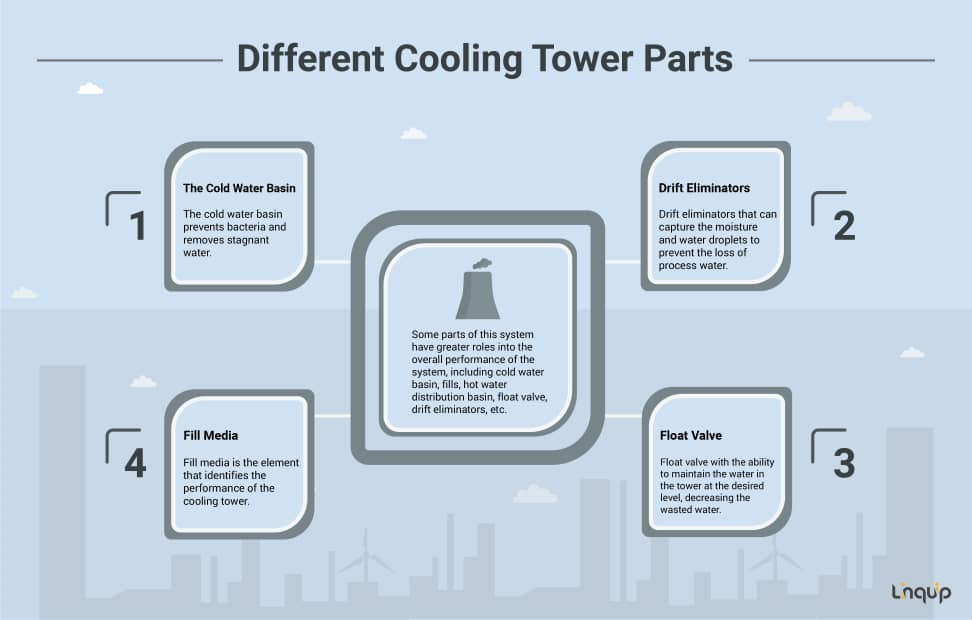
Cooling towers have different components and they consist of various parts working together to ensure the efficiency and proper functionality of the system. These parts wear out over time and require maintenance or retrofitting throughout the life of the tower. Below you will see major parts of a cooling tower and their functions.
Components, Parts, and Functions
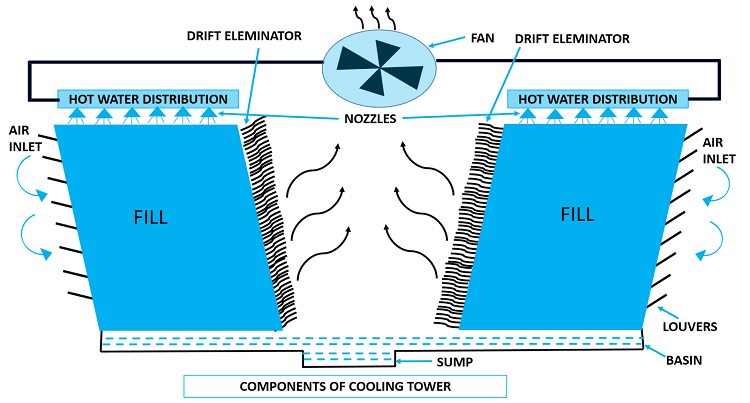
As mentioned earlier, ensuring the efficient and effective operation of cooling towers requires the parts to be in good condition. These important parts are replaced a few times during the tower’s lifetime. Next you will see the major cooling tower parts as they are presented one by one.
Cold water Basin
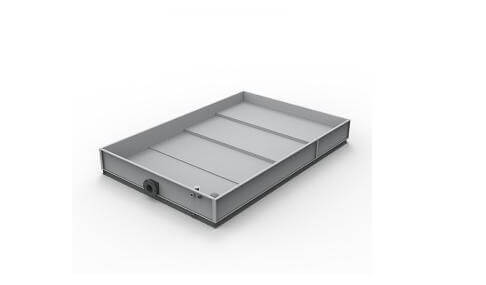
Cold water basin is one of the important cooling tower parts in which water is accumulated and directed to the sump or pump suction line.
Cold water basin’s job is to remove stagnant water and prevent the growth of bacteria.
They could also have heaters in order to avoid the freezing of water during cold weather conditions.
Fills
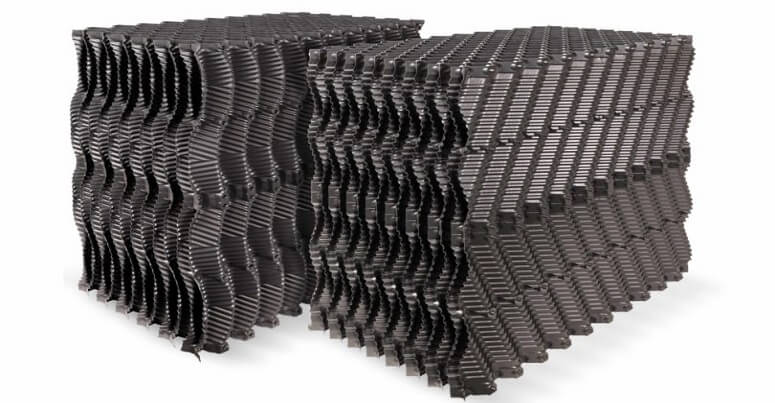
Fill material or fill media is another significant element among cooling tower parts. This element is, in a way, the most important part as it is the identifier of cooling tower’s performance.
A higher contact surface between the cooling and working media increases the rate of heat transfer between them. The main function of fills in cooling towers is to increase this contact surface as much as possible to ensure an optimum heat transfer rate between the air and water for as long as possible.
Fill media can be either of the film style type or splash style type. The film style fills, which is used in most cooling towers, produce thick water strips that increase the rate of heat transfer and also larger evaporation rates. splash style fills are commonly used in crossflow cooling towers in which water cascades down on staggered slats that breaks up water droplets to increase the water surface area.
Hot Water Distribution Basin
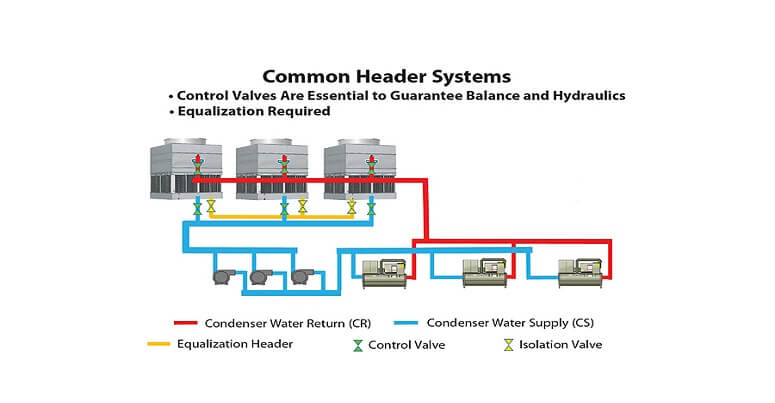
The (hot water) distribution basin is located above the fills where the hot process water accumulates. Due to corrosion and deterioration over time, they cannot provide a proper flow distribution down the nozzles to be sprayed over the fills resulting in significant loss of thermal performance and as a result they are replaced to avoid such downfalls in the system’s performance.
Nozzles
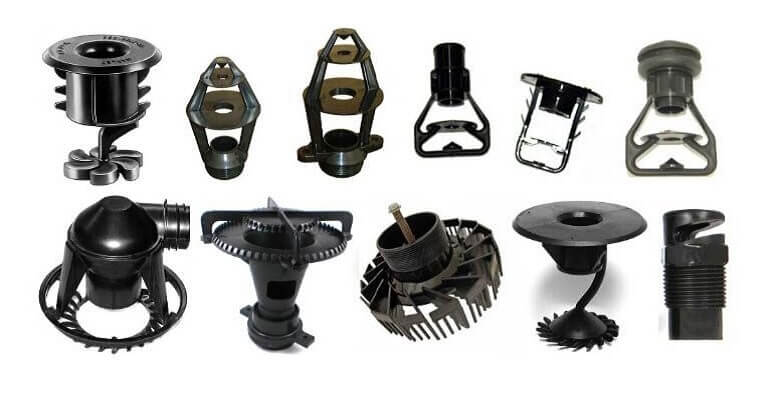
One of the cooling tower parts that is seen with crossflow cooling towers is the nozzles. In the case of crossflow cooling towers, water is raised to the distribution basins and then cascaded down over the fill through the nozzles on the hot water basin floor.
Cooling Tower Float Valve
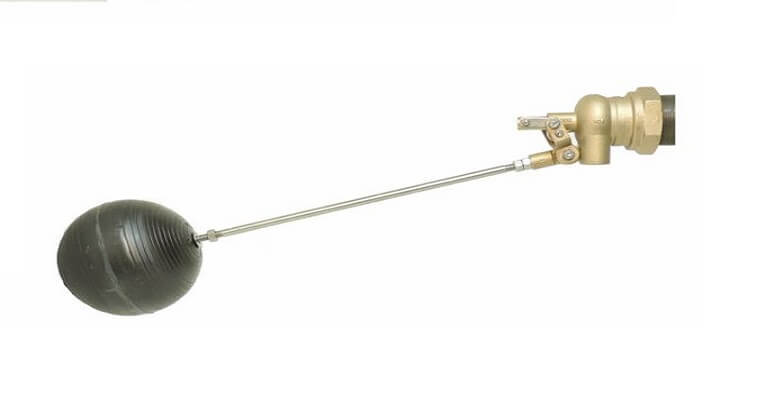
In order for the tower to operate properly, water inside the tower shall be maintained at the right level. Therefore, despite requiring only a little maintenance over time, float valves also become one of the necessary cooling tower parts.
Float valves adjust the water level and when properly calibrated in place, it guarantee that no water is wasted at the closing down of the pump in the overflow.
Drift Eliminators
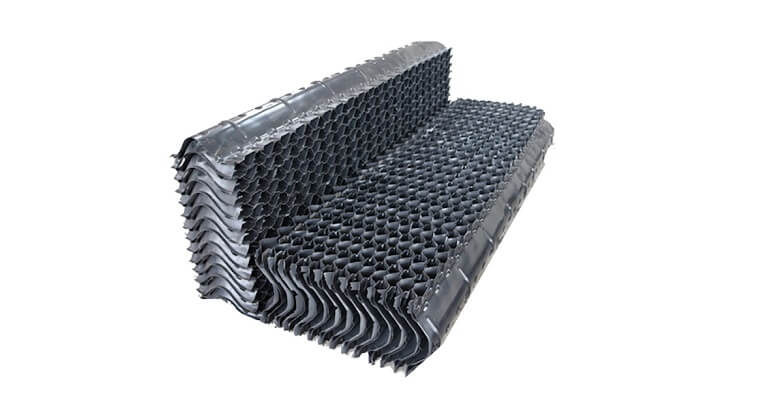
Another essential cooling tower part is the drift eliminator. The purpose of this device is to capture the large water droplets in the cooling tower air stream and minimize the loss of process water.
The eliminator redirects the moisture and water droplets towards another part of the system, preventing them from leaving the cooling tower. The air and water would afterward be separated and recycled for other operational purposes.
Apart from the necessity of process water loss prevention, the reason behind the elimination of these large water droplets is that they contain chemicals and minerals considered to be hazardous for the environment.
Water Distribution Piping

Water distribution piping system is also one of the other important cooling tower parts. Despite the fact that it is quite common for the heat generation points to be near to the cooling towers, the piping system routing and its physical dimensions depend on the type of the tower, site layout, and the topography of the area in which the site is located.
Cooling Tower Fans
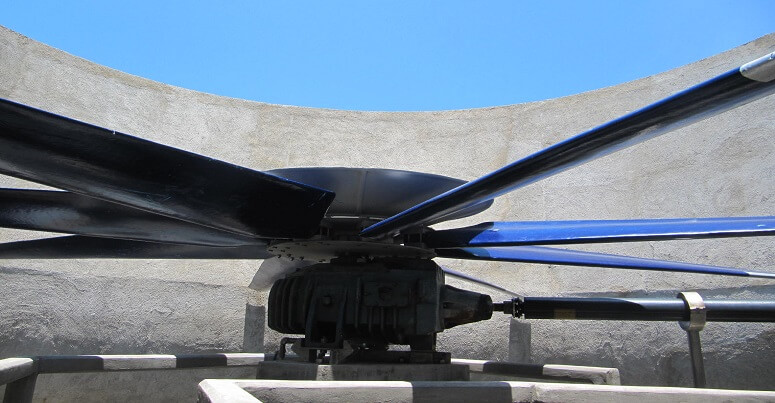
Natural draft cooling towers do not require any mechanical component to cause a draft. Nonetheless, fans are one of the significant cooling tower parts for mechanical draft, crossflow, and counterflow towers.
Noisiness is one of the considerations regarding the fans. Despite the fact that they are generally considered to be quite noisy, some designs are also available with lower levels of noise intensities while maintaining durability.
Gear Box
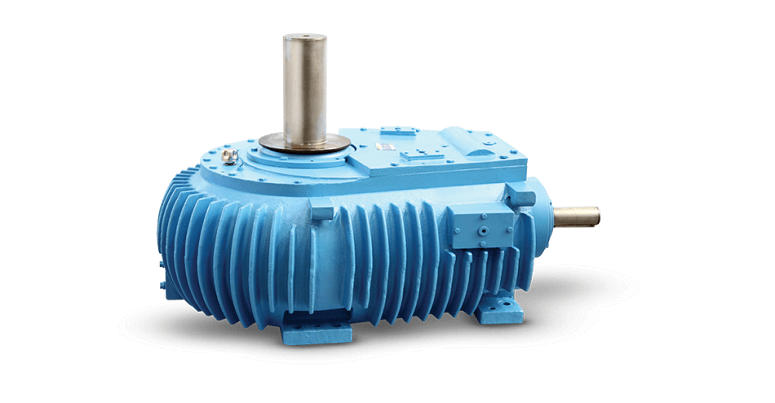
Those towers that have large fans to generate a draft, also have gearboxes for adjusting the power exerted on the fan’s driveshaft by the motor.
The gearbox is one of cooling tower parts that makes the mechanical system more cost-effective, not only by adjusting the rotational speed of the pump but also by acting as a torque multiplying agent so that the motor size would not require to be large.
Motor
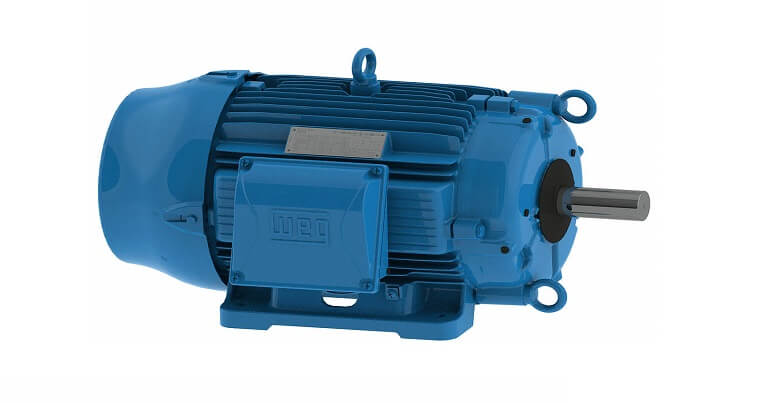
For the cooling towers with a fan, one of the necessary parts is the motor to drive the fan. Cooling tower fan motors are either of the open or totally enclosed type. The difference between these two designs is that the former is cooled down by the surrounding air while the latter is isolated from the surrounding and is cooled by media such as oil.
Driveshafts
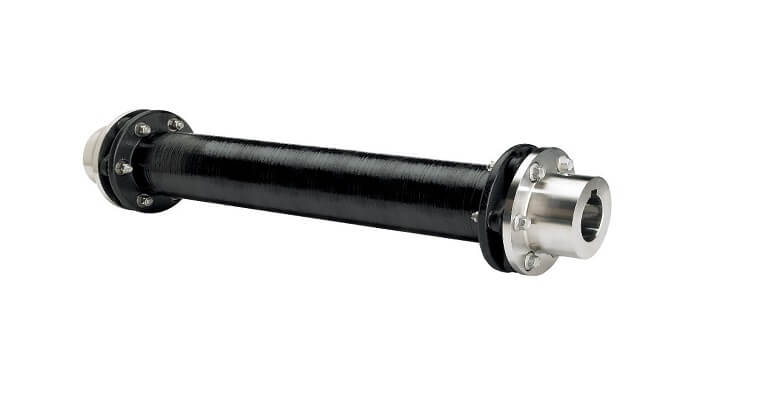
The power generated by the motor will be transmitted to the gearbox through the driveshafts making it one of the essential members of the cooling tower parts.
It must be noted that since the shaft is in direct contact with the internal atmosphere of the cooling tower, it necessitates the usage of highly-corrosion-resistant material in their manufacturing.
The driveshafts should also be capable of easy re calibration in case of shaft run out.
Air Inlet Louvers
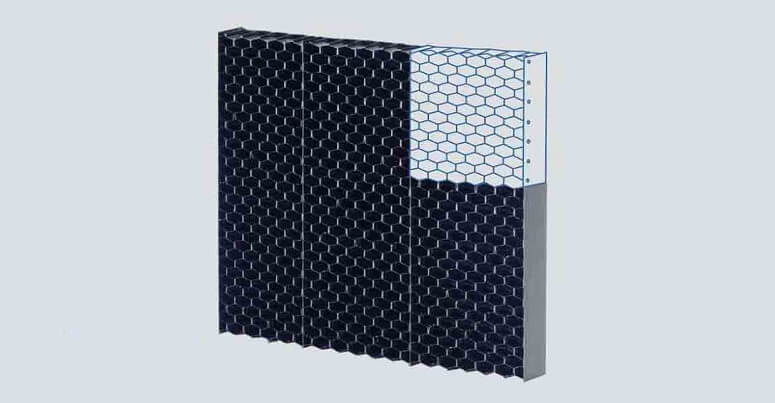
Air inlet louvers are responsible for blocking the water from splashing out of the interior of the tower preventing debris to enter it and also lowering the noise emission from the tower.
In order to maintain good thermal efficiency, external sources of heating the tower shall be minimized. The louvers also act as a shade to block the sunlight.
Want to know more?
To learn more technical details about the cooling towers and their parts you can click here for a good reference.
Buy Equipment or Ask for a Service
By using Linquip RFQ Service, you can expect to receive quotations from various suppliers across multiple industries and regions.
Click Here to Request a Quotation From Suppliers and Service Providers
Read More In Linquip
- A Quick Guide to the Crossflow Cooling Tower
- Cooling Tower Approach: Basic Elements of Efficiency in Cooling Towers
- Easy Guide to Cooling Tower Efficiency
- Drift Eliminator 101: A Convenient Overview
- Constructive Intro to Increasing Cooling Tower Efficiency
- Cooling Tower Fill Material: Gain a Deep Understanding

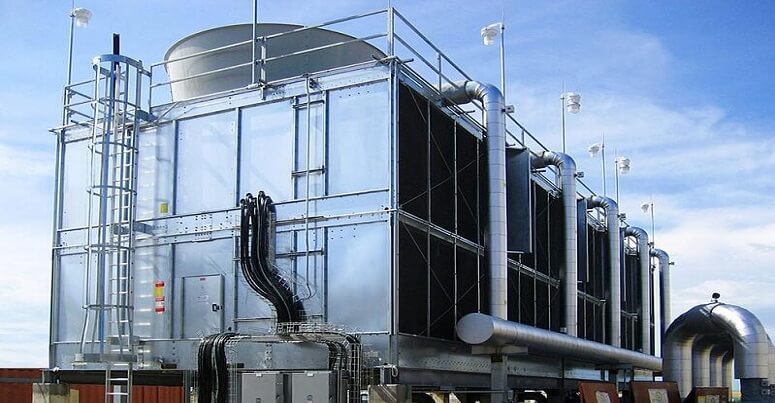



Where could I buy “Fill” elements for my house water cooled aircond?
Thanks for visiting our website. You can visit our Industrial Equipment page, where you can find various “Fill” elements based on your application and demand. You can also visit our expert page and take advice from hundreds of professionals on your issue.